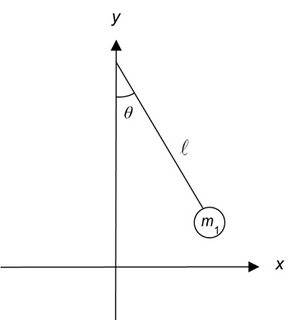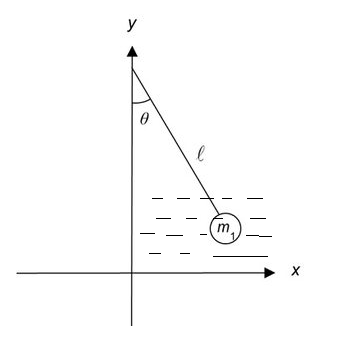
The bob of a simple pendulum performs S.H.M. with period ‘T’ in air and with period ‘\[{T_1}\]’ in water. Relation between ‘T’ and ‘\[{T_1}\]’ is (neglect the friction due to water, density of the material of the bob is $\dfrac{9}{8} \times {10^3}kg/{m^3}$ , density of water =$1g/cc$)
(A) ${T_1} = 3T$
(B) ${T_1} = 2T$
(C) ${T_1} = T$
(D) ${T_1} = \dfrac{T}{2}$
Answer
216k+ views
Hint Consider two cases of time periods. Calculate the effective g and find its relation with g in air. Since given data is in terms of density the mass is converted in terms of density as well. Then substitute the given data to obtain a relation between the two time periods.
Complete step-by-step solution


T and \[{T_1}\]are the time period of the simple pendulum in air and water respectively.
We know that the time period of the pendulum is,
$T = 2\pi \sqrt {\dfrac{l}{g}} $
The length of the pendulum l remains the same in both mediums but g is not the same so we need to consider an effective value
\[{g_e}\] for\[{T_1}\]
\[{g_e}\] is given by the difference between the weight of the bob and the buoyancy force when in water.
${g_e} = \dfrac{{mg - {f_b}}}{m}$
Here,
m is the mass of the bob
g is the acceleration due to gravity
\[{F_b}\] is the buoyancy force= mass of water displaced \[ \times {\text{ }}g\]
Mass is written in terms of density \[\rho \] using the formula,
$\rho = \dfrac{m}{V}$
${g_e} = \dfrac{{\rho Vg - {\rho _1}Vg}}{{\rho V}} = \dfrac{{g\left( {\rho - {\rho _1}} \right)}}{\rho }$
Where,
\[\rho \]is the density of the material of the bob $\dfrac{9}{8} \times {10^3}kg/{m^3}$
\[{\rho _1}\] is the density of water $1g/cc$
On substituting the values,
$
{g_e} = \dfrac{{\left( {\dfrac{9}{8} \times {{10}^3} - 1 \times {{10}^3}} \right)g}}{{\dfrac{9}{8} \times {{10}^3}}} \\
{g_e} = \dfrac{g}{9} \\
$
Since,
${T_1} = 2\pi \sqrt {\dfrac{l}{{{g_e}}}} $
Now, substitute the value of \[{g_e}\] in the above equation, we get,
$
{T_1} = 2\pi \sqrt {\dfrac{{l9}}{g}} = 3\left( {2\pi \sqrt {\dfrac{l}{g}} } \right) \\
\therefore {T_1} = 3T \\
$
Hence, the correct option is A.
Note The pendulum in water displaces some volume so it has to be considered to calculate the time period. Time period is the time taken to complete one oscillation about the mean position. It depends on the medium in which it is oscillating.
Complete step-by-step solution


T and \[{T_1}\]are the time period of the simple pendulum in air and water respectively.
We know that the time period of the pendulum is,
$T = 2\pi \sqrt {\dfrac{l}{g}} $
The length of the pendulum l remains the same in both mediums but g is not the same so we need to consider an effective value
\[{g_e}\] for\[{T_1}\]
\[{g_e}\] is given by the difference between the weight of the bob and the buoyancy force when in water.
${g_e} = \dfrac{{mg - {f_b}}}{m}$
Here,
m is the mass of the bob
g is the acceleration due to gravity
\[{F_b}\] is the buoyancy force= mass of water displaced \[ \times {\text{ }}g\]
Mass is written in terms of density \[\rho \] using the formula,
$\rho = \dfrac{m}{V}$
${g_e} = \dfrac{{\rho Vg - {\rho _1}Vg}}{{\rho V}} = \dfrac{{g\left( {\rho - {\rho _1}} \right)}}{\rho }$
Where,
\[\rho \]is the density of the material of the bob $\dfrac{9}{8} \times {10^3}kg/{m^3}$
\[{\rho _1}\] is the density of water $1g/cc$
On substituting the values,
$
{g_e} = \dfrac{{\left( {\dfrac{9}{8} \times {{10}^3} - 1 \times {{10}^3}} \right)g}}{{\dfrac{9}{8} \times {{10}^3}}} \\
{g_e} = \dfrac{g}{9} \\
$
Since,
${T_1} = 2\pi \sqrt {\dfrac{l}{{{g_e}}}} $
Now, substitute the value of \[{g_e}\] in the above equation, we get,
$
{T_1} = 2\pi \sqrt {\dfrac{{l9}}{g}} = 3\left( {2\pi \sqrt {\dfrac{l}{g}} } \right) \\
\therefore {T_1} = 3T \\
$
Hence, the correct option is A.
Note The pendulum in water displaces some volume so it has to be considered to calculate the time period. Time period is the time taken to complete one oscillation about the mean position. It depends on the medium in which it is oscillating.
Recently Updated Pages
Circuit Switching vs Packet Switching: Key Differences Explained

Mass vs Weight: Key Differences Explained for Students

Alpha, Beta, and Gamma Decay Explained

Alpha Particle Scattering and Rutherford Model Explained

Angular Momentum of a Rotating Body: Definition & Formula

Apparent Frequency Explained: Formula, Uses & Examples

Trending doubts
JEE Main 2026: Application Form Open, Exam Dates, Syllabus, Eligibility & Question Papers

JEE Main Correction Window 2026 Session 1 Dates Announced - Edit Form Details, Dates and Link

Derivation of Equation of Trajectory Explained for Students

Hybridisation in Chemistry – Concept, Types & Applications

Understanding the Angle of Deviation in a Prism

Understanding Collisions: Types and Examples for Students

Other Pages
JEE Advanced Marks vs Ranks 2025: Understanding Category-wise Qualifying Marks and Previous Year Cut-offs

Units And Measurements Class 11 Physics Chapter 1 CBSE Notes - 2025-26

NCERT Solutions For Class 11 Physics Chapter 8 Mechanical Properties Of Solids

Motion in a Straight Line Class 11 Physics Chapter 2 CBSE Notes - 2025-26

NCERT Solutions for Class 11 Physics Chapter 7 Gravitation 2025-26

How to Convert a Galvanometer into an Ammeter or Voltmeter




